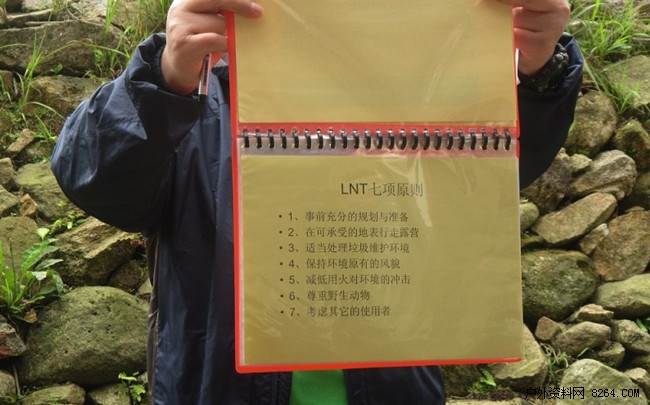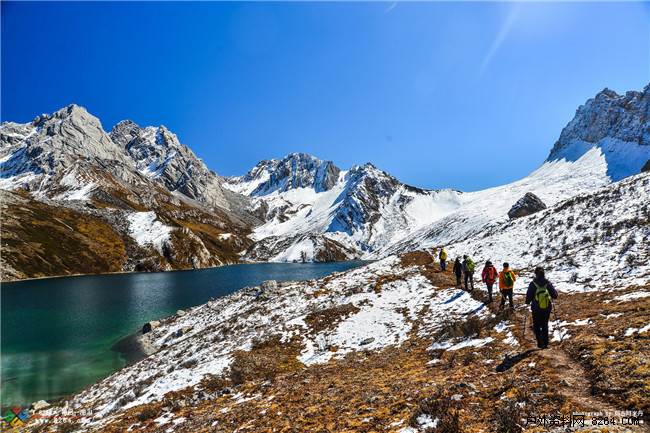This class, 8 called the beast for everyone to introduce an important law in outdoor activities - the smallest environmental impact rule, referred to as the LNT rule.

What is the LNT rule:
LeaveNoTrace is a national education promotion campaign jointly initiated by land administration agencies, environmental education scholars, conservation groups, outdoor product manufacturers and distributors, mountaineering and hiking groups, and the public. These public-private sectors and the cooperation groups formed by the industry and academia have proposed the concept of action for STI-free tourism since the 1980s and have fully promoted "responsible quality tourism." Teaching the public about the correct concepts and techniques of the environment, helping to minimize the impact of recreational activities on nature, and successfully achieving good results over the years.
LNT introduction:
The population of outdoor activities from 1965 to 1994 grew by a factor of six. Surveys conducted by outreach schools showed that 9.9 million Americans engaged in hiking activities in 1965, and by 1977 the number had increased to 28 million. Mountain lakes are contaminated by human excretions. Some trails are eroded to deep knees. Camp grasses are not growing. Large and small garbage can often be found. This phenomenon causes land managers to face a dilemma because they must meet the needs of tourists. , but also try to protect the natural environment.
In the early 1980s, the initial LNT courses in the forest sector began to be introduced into other outdoor activities. When closing certain areas of overuse, carrying capacity control, and restricting certain camps as important management tools for land managers, the environmental education for tourists is actually a more effective solution. In the early 1980s, there were countless environmental education courses taught in the land management unit, such as “The back of the mountain has to carry things downâ€, “Lightly step on the landâ€, “Only take photos and leave only footprintsâ€. Many slogans such as this slogan Are familiar. In 1994, Leave NoTrace, Inc., a non-profit organization headquartered in Boulder Colorado, coordinated the coordination of all LNT units, and issued licenses and fundraising work.
The main content of the LNT rule:
First, plan ahead
Any outdoor activities need to be well prepared in advance to understand the rules and regulations concerning environmental protection at that time, make adequate preparations for possible situations, and select applicable equipment according to what is known. At the same time, it is necessary to fully understand the route characteristics of the active area and accordingly design the route of travel and the campsite in advance. According to the actual situation of the line plan the number of foods carried, and then the simple processing of food, can unpack the centralized packaging as much as possible to focus on packaging, reduce waste generation as much as possible, simply, plan ahead and prepare to do: Blind, non-infringement, waste, and preparation.
Second, in the tolerable ground marching and camping
In outdoor activities, sometimes we often choose disorderly routes to shorten the distance and difficulty. This is not desirable. The Law of LnT stipulates that whenever and wherever possible, it should walk on existing trails. It does not take short cuts and does not go straight up and down. The team only takes a single course of travel when it travels. If the road conditions are good and the backpack is not too heavy, soft-soled shoes can be considered to reduce the impact on the ground.
When hiking on non-hiking trails, choose places where people can step on rocks, such as bare rock or gravel slopes. In such areas, walking is the best choice to reduce the impact on the environment.
The choice of campsite is very important in camping activities that have a great impact on the environment. In general, we will require the camp to choose a location more than 50 meters away from the water source to eliminate pollutants. In the popular route, camping is conducted only on camps where the existing soil is hard and the camp is not camped, and camp activities are concentrated in areas that have already been hit. If you are in an area where there is little human activity, put the camp in a place that has never been used, and do not place it in a slightly impacted area. Encampments are made on existing camps with obvious traces. On existing camps, there are sometimes signs of fire. If it is a camp that is used very frequently and the ground is seriously eroded and the roots are exposed, it is better to choose to camp elsewhere and give the camp a chance to rest.
The best places for camping are rocks, gravelly grounds and sandy lands, because they are very tolerant of human foot-breaking. Other good choices are dry grass. Those who are more intolerant of human impact are the forests that are rich in vegetation and cover the foliage of the ground. Ground.
Third, properly handle garbage
“The things on the back of the mountain must be carried down.†This is an important principle. Keeping the original appearance of the campsite reflects the most basic qualities of campers. The treatment of excretions can be buried in a cat hole 10-20 cm deep and at least 60 meters away from water, camp or trails. This is accepted. Thinking carefully about the issue of toilet paper, Nature has provided many friendly ways to the environment. If you must use toilet paper, you have to carry it back down. This is very important to our attention.
When dealing with food waste, we try to reduce packaging before we set off, and we also choose to use reusable appliances as much as possible, and plan appropriate amounts to avoid waste. In camping activities, use as few cleaning supplies as possible. Do not wash your face, brush your teeth, wash your clothes, or wash vegetables directly in the water. Sewage is poured into pits 25 to 30 cm deep and more than 50 meters away from the camp and water source. The residue of the food should be taken away. Even some of the degradable foods such as seeds and peel must be taken away.
While dealing with excreta, temporary toilets should be built during camping activities to cover excreta. The position of the toilet should be located 60 meters away from the water source, campsite and road. To avoid secondary pollution, the toilet paper used should also be packed and taken away, and not buried or burned.
Leave a clean camp and carry all the rubbish down, along with other people's leftovers. Put your trash in a single garbage bag. At the camp, lighter shoes with relatively flat and soft soles, such as sports sandals or jogging shoes, were used to reduce the impact of stampeding on the land. The lighter tents also impacted the environment than the old-style canvas tents. It's small. When you leave the camp in a pristine area, make the grass fluffy; fill in the hole left by the nail.
Facing the mountain, even if there are even better scenery, the rubbish everywhere will clear your good mood!

Fourth, keep the natural appearance
Also natural in itself. When we are in the camp, we should choose to wear lighter shoes with relatively flat and soft soles, such as sandals, slippers, or jogging shoes, to reduce the stepping on the land. Encounters untouchable situations such as culture, historical footprints, artificial sculptures, and architecture. At times, during the event, we found that some of the team members picked flowers and climbing rockery high walls. This is undesirable and should be stopped. In the construction of the camp, care should be taken not to dig trenches, change the course of the stream, and return the camp to a place where it can attract later campers when it leaves, so as not to destroy other grounds.
V. Fire in the Wild
Do not use fire in the field. Generally speaking, the fire will have a great impact on the natural environment. Once a fire is fired, its marks will become larger and larger and will never disappear. The permanent damage caused by fire to the soil can be deepened. Up to 10 cm, therefore, in outdoor activities, use proper stoves for cooking, wear enough warm clothes, use tents, use a good sleeping bag to keep warm and dry, instead of using the fire lightly.
When you have to use firewood, you must first determine whether your place is allowed, whether it is a fire-proof season, and be sure to find wood instead of fuel to harvest live trees. The ideal fuel is a branch that is thinner than the wrist. When you are igniting, you have to choose to put the fire in the central area where there are traces of the fire. After the raft is completely burned, soot is sown in the grass.
In outdoor activities, we don’t advocate smoking. In addition to the “toxic†harm caused by tobacco itself, its cigarette butts are made of cellulose acetate plastic and are non-degradable. The used cigarette butts also contain lead, mercury, arsenic, acetone, and vinyl chloride. , formaldehyde and hydrogen cyanide in the smoke. Even if you must smoke, you must keep away from your teammates and do not cause secondary pollution. Cigarette butts also need to be disposed of together with garbage.
Respect for Wild Animals
In outdoor activities, we should respect the habits and environment of wildlife survival and achieve a peaceful coexistence with them. Care should be taken to protect the water and protect the animals' survival. Whether you see wild animals or not, you should know that your brief visit will inevitably affect the local wildlife. When you camp near a water source, Try to return water only once to reduce the interference to wildlife and carry collapsible water bagged water. Do not use pots to send water directly back and forth. This way, you only need to send water back and forth once to reduce the interference to animals.
At the same time, they should never feed wild animals. No matter how cute a wild animal is, they should not feed them freely. Once they lose their ability to survive, they are victims of these wild animals. At the camp, put all food and attractions in a safe place so as not to allow local wildlife to develop the habit of visiting the camp.
Observe from a distance to avoid feeding and coexist peacefully with wild animals.
Seven, consider other field activists
Before the start of outdoor activities, you should fully understand local customs, respect local customs, respect other people’s habits and customs, and develop good habits. The entertainment in the camping area should not interfere with others, minimize the noise and visual disturbances, and do anything you can think of to maintain the tranquility of nature and the camp because it is the reason why most outdoor lovers get close to nature.
Respecting nature, caring for nature, and maintaining ecological balance are the unshirkable responsibilities of our outdoor enthusiasts. Whether it is in the city or in the open air, it promotes environmental protection, starts from ourselves, influences others through our actions, and disseminates the correct concept of environmental protection so that our children and grandchildren can enjoy this blue sky and green water.
In the outdoors, nothing is left except for the footprints; nothing but photos and fresh air should not be taken away.
Glass Candle Holder,Crystal Candle Holder,Glass Pillar Candle Holders,Large Glass Candle Holders
Shaanxi Freeway Export and Import Co.,LTD , https://www.fw-deco.com